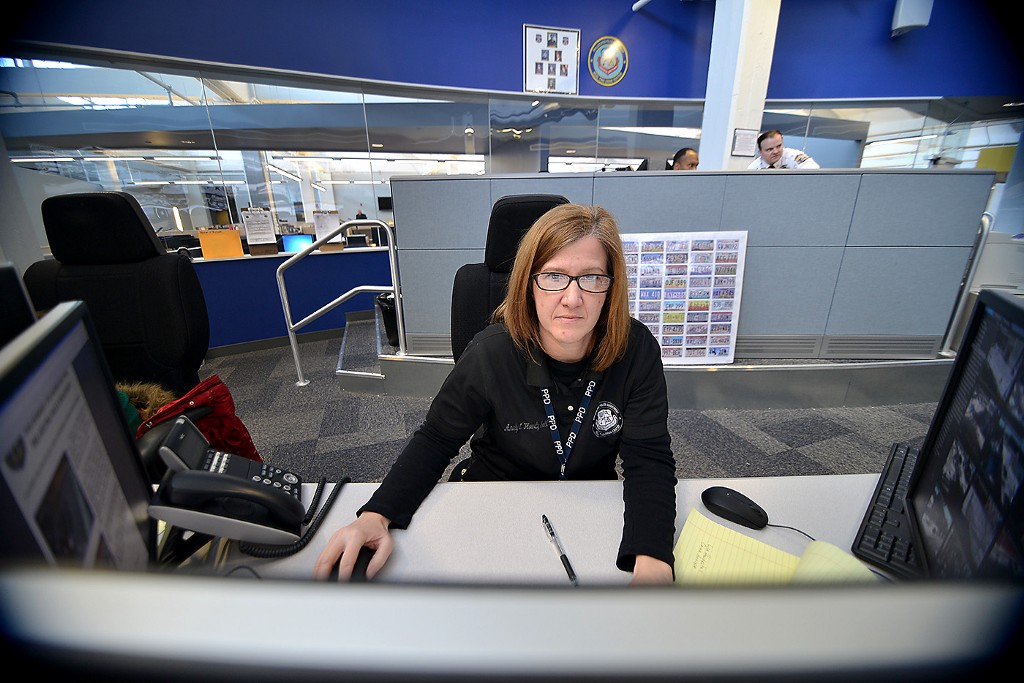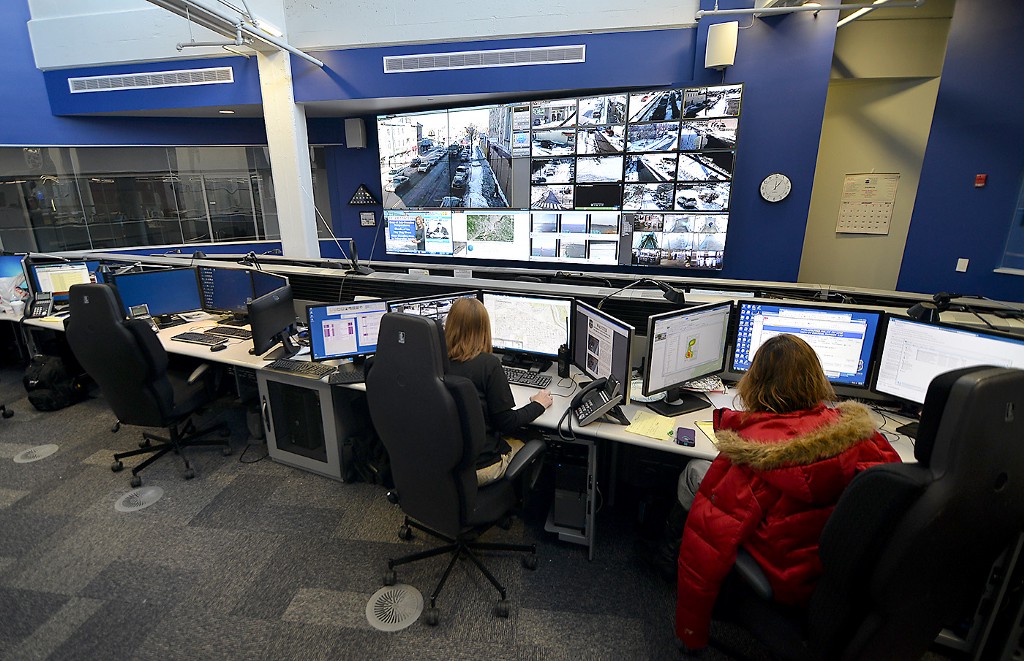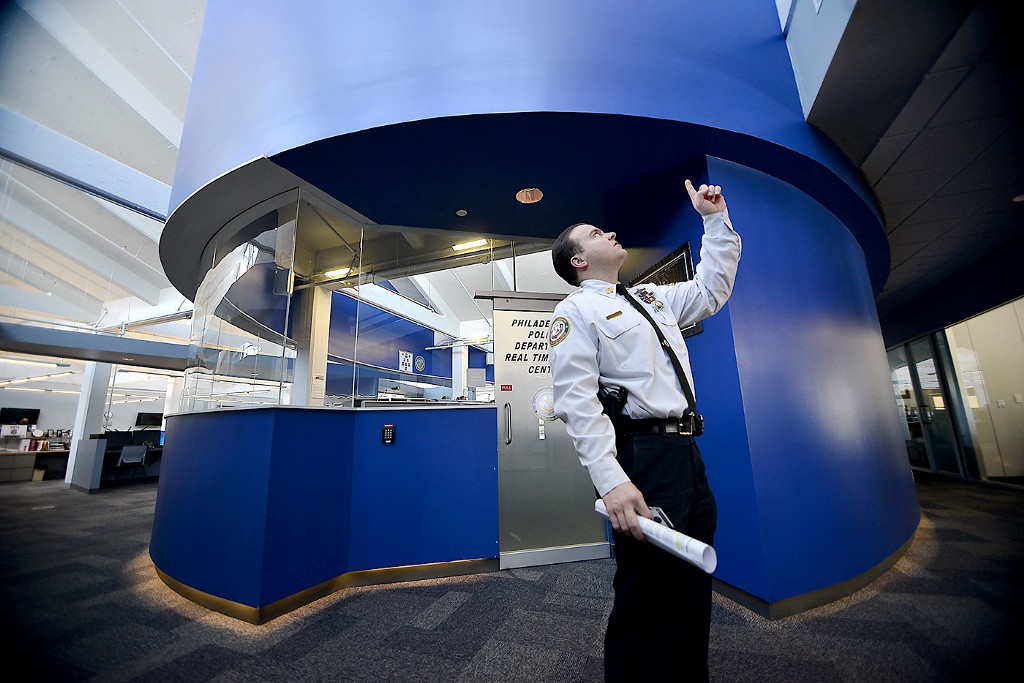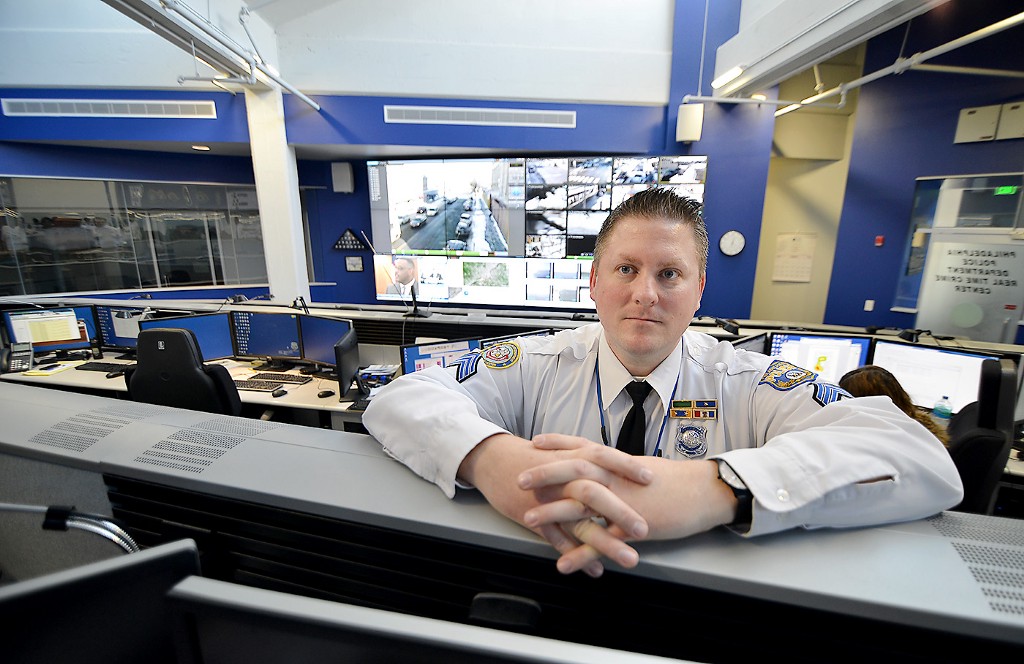Curtis Heckman, transit analyst at the center, answers a tip-line call from an anonymous source.
There are Philadelphia police officers and civilian employees who are sitting in a room in South Philly who can track a smartphone stolen in Oxford Circle, watch what’s going on at Arrott and Griscom streets in Frankford, search for a car believed to be involved in a murder and look for crime patterns.
The staff of the Real Time Crime Center has interconnected computer systems, software, maps and big-screen monitors that are tied into a thousand cameras on the city’s streets and to cameras mounted on police cars that read every license plate those cars pass.
And, really, that’s not even the half of it.
What the people in a glass-enclosed room they call “the watch room” or “the bubble” do is feed information to the cops who patrol your neighborhood.
Capt. Derek Kephart, RTCC’s commander, and all of his officers and analysts can tell story after story about how they work with patrol officers and detectives.
In December, for example, a car stolen in the suburbs was driven into Philadelphia where police stopped it and found the thief still behind the wheel. His arrest led to his confession to involvement in four armed robberies and the arrest of three accomplices. Those arrests led police to close several cases in the city and suburbs.
Finding that car and making those arrests, said Lt. Brian Sprowal, is one of the success stories of the Real Time Crime Center, which in June moved into one of the old Quartermaster buildings at 20th and Oregon.
According to Sprowal, one of the watch room’s supervisors, the gist of what happened is this: Suburban police reported the license plate of the stolen car to the Real Time Crime Center. Officers fed the plate number into the computer software that is used by computers in patrol cars equipped with cameras that read every plate those cars pass. One of the Automatic License Plate Readers flagged the car. Officers checked to make sure the car was still wanted and made the stop.
It’s sort of a rule of the universe nowadays that every robbery involves a phone, and the officers in the bubble can track stolen phones. A robber will take a phone from a victim to keep him from calling police or to sell it. If a robber doesn’t immediately toss a phone, police have a good chance of catching up to him, or, even if he gets rid of it, at least, recovering the phone.
It’s now Police Department policy for officers responding to a robbery report to ask victims for information about their phones, including passwords. That was the idea of Chief Inspector Dennis Wilson, boss of Regional Operations Command North, now located at Bustleton Avenue and Bowler Street. Phone information is immediately forwarded to the RTCC, and an officer there starts tracking the phone, relaying its position to patrol officers.
Sgt. Joseph Green, who worked in Northeast Detectives before transferring to the RTCC, said he was working a case with some detectives who had information on a stolen phone. They gave Green the phone number and the owner’s password, and Green was able to pinpoint the phone’s position within a few meters. He also could send an alarm through the phone so the pursuing detectives could hear where it was, stop the robber and get the phone back.
Green helped cops find a phone in the snow by getting them close to it and then sending the alarm signal through it so they could find it. The phone had a thumbprint on it, Green said, and that led to an arrest.
Civilian analysts Lisa Howdyshell and Erin Fagan on Jan. 24 were looking at data that related to a murder.
On one of the three computer monitors in front of her, Howdyshell had a map of the area around the site of the slaying. She was looking for nearby robberies and other violent crimes, trying to spot a trend that might help police find the killer. Fagan was looking through data gathered by license plate readers, trying to find a link to the murder.
The license plate reader’s cameras feed images to the RTCC and also to the officer or officers in the patrol car. If, for example, it reads a tag of a stolen car, the information appears on the patrol car’s computer screen. The officer pulls over to verify the information. The GPS-equipped scanner can pick up on cars known to be used by fu-git-ives. Moving vehicles can-not be stopped just be-cause the com-puter gives of-ficers matches. Of-ficers must veri-fy the in-form-a-tion. What they’re get-ting, es-sen-tially, is a heads-up.
The reader’s computer software tells the of-ficer who the fu-git-ive as-so-ci-ated with the scanned car is and why he or she is wanted. The sys-tem works sim-il-arly for miss-ing per-sons.
Also, the of-ficers will learn if a scanned vehicle is linked to a spe-cif-ic ter-ror-ist watch and they’ll also be giv-en alerts about wheth-er they should not stop cer-tain vehicles.
WATCHING, ALWAYS WATCHING
Detective Erik Paller, who on Jan. 24 also was looking at data coming in from license plate readers mounted on the police cars, looked over at a large wall covered with monitors being fed from city cameras. He took control of the camera mounted on a pole on Germantown Avenue. The camera usually rotates and gives watch room staffers a 360-degree pan of an area, but Paller turned it and and kept it focused on a parked truck. He zoomed in and zoomed out to show how much control of the camera he has.
What is noticeable, Kephart said, is the camera is pointed at public areas. The city’s cameras aren’t positioned so they could look into people’s homes or otherwise invade individual’s privacy, he said.
The cameras are placed based on crime analysis and feedback from police districts.
Kephart and unit supervisor Sgt. Jay P. Bowen III called the cameras “force multipliers.”
“That’s an accurate description,” said Inspector Walter Smith, commander of the Delaware Valley Intelligence Center, the umbrella organization that oversees Real Time Crime. “You utilize a camera to do something it would take two or three officers to do … so officers can be deployed in areas that they are really needed.”
Bowen said the watch room can monitor parades and other outdoor events, spotting trouble or thickening crowds. During Superstorm Sandy, the bubble’s staffers could spot areas that were flooding.
The watch room knows where all the city’s cameras are as well as those operated by other agencies, like SEPTA, Bowen said. The RTCC also has “after the fact” access to recordings made by hundreds of privately owned surveillance cameras that are part of the Police Department’s SafeCam program. Owners voluntarily sign up to let police know where their cameras are and agree to give police access to their recordings.
“We have made arrests through SafeCam,” said Capt. Joseph Zaffino, commander of the Northeast’s 7th Police District. “SafeCam is absolutely a plus … It’s one of the best programs we’ve implemented since I’ve been on the job.”
There is an app smartphone owners can buy to help police track phones if they are stolen, the captain said.
“As soon as they purchase a phone, they should have the sales clerks show them how to download the app,” Zaffino said.
HIGH-TECH POLICING
Bowen pointed to a map of the Broad Street Run. Some dots on that map indicated city-owned cameras; others spotted private cameras whose owners signed them up for SafeCam. Kephart said SafeCam provide surveillance recordings, not live feeds.
Balancing the technology so it aids law enforcement while not violating civil liberties is a key part of running the Real Time Crime Center and all the other agencies that are part of the Delaware Valley Intelligence Center, said Smith.
Using cameras and license plate readers and any technology to fight crime is always based on the idea that police have to have a reasonable suspicion that something criminal is occurring, Smith said.
“We don’t break the law to enforce the law,” Smith said. “We make sure we follow the guidelines for purging data.”
Bowen and Kephart said that information police get to track a stolen smartphone is kept for a single day. The visuals of the tags recorded by license plate readers on patrol cars is kept for a year, they said.
Large as the watch room is inside a building where flags used to be sewn, it is inside a much bigger room in Building Six at 20th and Oregon. That huge room is without walls so that detectives from Philadelphia police units like Real Time Crime, Criminal Intelligence, Homeland Security and High Intensity Drug Trafficking know each other and easily share information along with agents from the U.S. Drug Enforcement Agency, the U.S. Coast Guard and the federal Homeland Security unit, Kephart said.
These are the agencies supervised by Smith in the Delaware Valley Intelligence Center. They’re there in one place so their detectives and agents are available to each other and so is the information they all have.
Real Time Crime began two years ago in the basement of the Police Administration Building at 8th and Race streets, and it began small with just a couple of computers. As it grew, the officers and civilian analysts got more sophisticated equipment and software that broke down the walls that separated the collections, or silos, of information they need to do their jobs.
“No information silos,” Bowen said. If there is a mantra in the bubble, that is it.
It’s not a difficult concept to grasp. One type of information would be stored in one database on one type of computer. A second on another computer and so on. Bowen said an analyst would have to move from one computer to another to chase down information on different databases. Those individual databases were like grain silos, each containing grains of information they couldn’t share with each other.
Now, Kephart said, RTCC staff can get to everything from one computer.
“It’s interconnected,” Bowen said.
Zaffino said he gets a lot of information from the Delaware Valley Intelligence Center.
“I get at least a dozen alerts a day on my Blackberry,” the captain said. Anything noteworthy in law enforcement — from anywhere — he is informed about it, the captain said. It could be something in Philadelphia or a school shooting in Sacramento, he said, and he will be told.
“They are so on top of things,” Zaffino said.
ONLY SO GOOD
“We have a ton of technology in the Real Time Crime Center,” Smith said. “Technology’s great, but if you don’t have the people to run the technology, it will just sit there stagnant, it wouldn’t be of any value.”
It’s not just technological know-how that’s important, Kephart said. The cops in the watch room know the streets they’re watching. Kephart said he requires five years experience for all sworn officers who man the watch room.
Another element in making the bubble work is community involvement, Smith said.
“We are very interested in connecting with local groups,” he said, adding that will be a DVIC goal for 2014. He said he wants organizations to tour the facility and use its conference room.
“There’d be nothing wrong with having the 2nd PDAC [Police District Advisory Council] meeting right here,” he said.
Kephart, Smith and Bowen stressed that the DVIC is an open environment and that they are part of the city’s neighborhoods, too. Kephart’s a Bridesburg guy; Smith’s from Port Richmond; and Bowen, originally from Olney, lives in Somerton.
“If you don’t have that community support and relationship, nothing really works,” Smith said.
The watch room is getting some of that support.
“I’ve had emails from community groups in which they’re asking: What can I do for you?” Bowen said.
What Smith would like to see is portable cameras that could be placed quickly and temporarily to help with temporary problems in the city’s neighborhoods.
Temporary cameras don’t require a lot of infrastructure, Smith said. They could be useful in the Northeast’s 2nd Police District, which has next to no cameras.
“In the 2nd District, portable cameras would be good for me because I could put them in very quickly,” Smith said.
“Right now, we have temporary problems that need temporary solutions,” Bowen said. “Say prostitution pops up in an area in the Northeast … it could be a temporary problem … We’d like to put the cameras out there … letting them know that they’re under surveillance and to move on.”
The crime cameras the city currently has are permanent solutions to ongoing, chronic problems, Bowen said.
“Portables let officers cover gaps in camera coverage,” Bowen said. “We would be able to handle that problem and move them to other areas. … Sometimes in the summer, we have drag racing pop up … along Red Lion and the Boulevard …We could pop a couple cameras up there.”
Kephart wants to see and always have the latest software available for his unit. Right now, he said RTCC is the cutting edge, and police from all over the country come to Philly to see how things are done in the bubble.
What Real Time doesn’t have yet, but is getting, are gunshot detectors. These will be attached to cameras and point those cameras in the directions gunshots are detected. The city currently is completing negotiations to buy the detectors. ••

Fighting crime: Lisa Howdyshell, crime analyst at the Real Time Crime Center, gathers information for a report.

The inside of the dome has a large screen that shows camera feeds.

Caught on camera: Capt. Derek Kephart, the Real Time Crime Center’s commander, points to a dome where employees track criminal activity throughout the city using more than 1,000 cameras.

Patrolling technology: Sgt. Bowen explains how officers and detectives can zoom with each of the 1,000-plus cameras tracked on the big screen. He stresses that the cameras track criminal behavior only and not civilians going about their days. MARIA POUCHNIKOVA / TIMES PHOTOS





